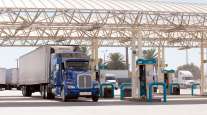Plan Would Save Truckers 33% in Pennsylvania Taxes

[Stay on top of transportation news: Get TTNews in your inbox.]
It’s only an idea for now, but Pennsylvania’s proposed switch from a fuel tax to a miles-driven fee to help generate more money for transportation could be a boon for the trucking industry.
Based on the Transportation Revenue Options Commission recommendation to switch delivery and freight trucks from a diesel tax of 73 cents a gallon to a miles-driven fee of 8.1 cents, the cost to truckers would drop by an average of almost 33%. That’s based on figures provided by the Pennsylvania Motor Truck Association that show the average truck now pays about 12 cents a mile in state taxes.
Based on 13,000 miles driven in a year — although many truckers average more than double that — and an average of 6 mpg, the cost would drop to $1,053 from $1,582.
But for passenger vehicles, based on 13,000 miles a year and a vehicle that gets 25 mpg of gasoline, the cost would more than triple.
With Pennsylvania’s gasoline tax at 58.6 cents a gallon — second highest in the country behind California — that motorist now pays $306 a year. With the miles-driven fee, that driver would pay $1,053 annually.

Oyler
The potential that truck operators could have reduced costs if the state switches to fees based on miles driven was unexpected, Pennsylvania Motor Truck Association CEO Rebecca Oyler said.
She served on the commission and said she realized there hadn’t been a separate fee recommended for truckers but figured that was just a detail the commission didn’t get to during its five-month mission.
Alexis Campbell, a spokeswoman for the state Department of Transportation, said it wasn’t an oversight and the commission intended to recommend the same fee for all motorists.
“[The Transportation Revenue Options Commission] did not differentiate between passenger and commercial vehicles for the purposes of its analysis and when setting its example rate of 8.1 cents,” she said. “Rate setting is complex, and discussions around a potential [miles-driven fee] will be ongoing.”
Oyler said her members would be glad if they would save money.
“Obviously, that would be great for truckers,” she said. “In the context of what truckers pay now, I don’t know whether that would hold when they actually set the rate.”
Right now, Oyler said, truckers provide about 38% of the fuel tax revenue that Pennsylvania receives. It would be a nice surprise if changing the funding system helped the industry by substantially reducing that percentage, she said.
“We know trucks have a greater impact on the condition of roads than passenger vehicles, so that’s why they pay more,” she said. “That 38% is a huge amount of the overall money, and I would be surprised to see that come down much. I’ll be interested to hear if that changes.”
Under the plan, motorists with more fuel-efficient vehicles would pay the same as a person with a gas-guzzler. Their current advantage with the gasoline tax would go away.
For example, for a driver with a vehicle that can go 40 mpg, the gasoline tax amounts to $190 a year now. Under the miles-driven fee, that driver also would pay $1,053.
Put another way, the more efficient a vehicle is, the more expensive it would be to drive.

What's next for data gathering and analytics programs in trucking? Host Seth Clevenger speaks with Andrew Johnson of PrePass Safety Alliance and Chris Orban of Trimble Transportation. Hear a snippet above, and get the full program by going to RoadSigns.TTNews.com.
Campbell said those figures seem accurate but she stressed that more study needs to be done before legislation is developed to switch to the miles-driven fee. Transportation Secretary Yassmin Gramian chaired the 42-member group appointed by Gov. Tom Wolf in February and PennDOT officials served as the support staff for the commission.
Campbell called the proposal “an exercise” to show how funding could be changed and revenue increased to pay for road work. The department says spending needs to be more than doubled, to $15 billion a year from the current $6.9 billion, to meet transportation needs.
Completely switching to the miles-driven fee probably is 10 years away, in the third phase of the commission’s plan for eliminating fuel taxes. The plan also calls for new fees for package deliveries ($1 each) and rides with services such as Uber and Lyft ($1.11 per ride).
Overall, Oyler expressed concern that the commission rushed through its work to finish by Wolf’s Aug. 1 deadline. As a result, she agreed with Republican legislators that the group only looked at ways to generate additional funds, not ways to cut costs.
“The commission was given a really bold charge — find a way to eliminate the gasoline tax,” she said. “I just don’t think there was great time given to finding ways to save money, just how to generate revenue.
“We eventually pushed ahead with the funding options and said, ‘OK, all of the above.’ Everyone at every point where they come into contact with the transportation system will have to pay something.”
Since fuel tax revenue is becoming stagnant with gasoline vehicles becoming more efficient and the growth of electric vehicles, it makes sense for the state to switch to a fee for miles driven, Oyler said.
The commission recommended that the Wolf administration spend the rest of the year refining proposals and building support for the recommendations and make a big push when the governor introduces his budget in February.
Post-Gazette staff writer Joel Jacobs contributed.
Want more news? Listen to today's daily briefing below or go here for more info:
Distributed by Tribune Content Agency, LLC




